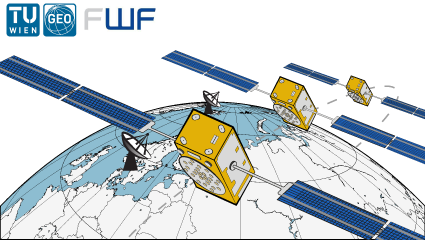VLBI observations to Galileo satellites – for improved orbit determination

Graph by H. Wolf
Project Partners:
- ETH Zürich
- TU München
Proposal Abstract:
Space geodetic techniques are essential for the determination of global geodetic reference frames, which are the basis for every kind on positioning and navigation on Earth and in space. These reference frames are the realization of Earth-fixed and space-fixed coordinate systems, including the Earth orientation in space for the transformation between the two systems. One important component of Earth orientation is the non-uniform rotation about its axis in about 24 hours. The determination of the corresponding Earth rotation angle with microsecond-accuracy is of utmost importance for exact positioning at the millimetre-level with Global Navigation Satellite Systems, such as the United States Global Positioning System (GPS) or Galileo of the European Union. While GPS or Galileo rely on measurements between Earth orbiting satellites and antennas on the ground, Very Long Baseline Interferometry (VLBI) uses globally distributed radio telescopes and the observation of quasars, which are extragalactic radio sources billions of light years away. The primary observable in VLBI is the difference in arrival time of the signal from the quasars at the radio telescopes. VLBI is the only technique of the determination of the Earth rotation angle, as the satellite techniques suffer from unmodelled errors in the satellite orbits. The goal of project VLBI2Galileo is the transfer of the advantages of VLBI to Galileo with a new type of observation.
The only geometric ties between the two space geodetic techniques stem from local measurements at co-location sites on the ground, as there is no link between the techniques in space. In this project, we investigate the benefit of VLBI transmitters on board Galileo satellites, i.e., we assume that Galileo satellites are emitting signals similar to quasars. These signals can then be observed with VLBI radio telescopes realizing ties between the techniques in space. In consequence, these observations will enable the direct observation of the Earth rotation angle by Galileo observations, which is currently not possible. Additionally, we investigate the application of specially designed time encoded signals for ranging between the Galileo satellites and the VLBI radio telescopes, which will particularly improve the radial component of the Galileo orbits.
We are going to use the Vienna VLBI and Satellite Software (VieVS) for extensive simulations to optimize the schedules (at what time should which VLBI radio telescopes observe which satellites and quasars) for the best possible determination of Galileo orbits and references frames. Finally, we will be able to provide information about the accuracies, which can be achieved with these new observation types.
Contact:
- Johannes Böhm, johannes.boehm@tuwien.ac.at
- Axel Nothnagel, axel.nothnagel@tuwien.ac.at
- Helene Wolf, helene.wolf@tuwien.ac.at
